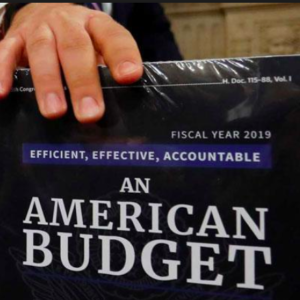You probably have heard the puzzler. Which is safer: a one-engine aircraft, or a two-engine aircraft? There follows a clarifying question: Can the two-engine aircraft fly on one engine? If not, then the two-engine aircraft has twice the probability of a crippling failure of one engine, and so it is definitely not safer.
The president’s new budget takes this puzzler two steps further: It is a four-engine aircraft that cannot fly on three. And each of those engines has a history of failure.
Unlike many recent budgets (including the one two years ago) that promised (in vain) to balance in 10 years, this one takes 15 years. And over that record-long flight, it assumes year after year of unprecedented action and good news on four different fronts. Failure on anyone could send the already excessive deficit up instead of down.
First, the budget assumes an extraordinarily long run of rapid economic growth — about half again as fast as since the start of the financial crisis — which is also the start of the retirement of the baby-boom generation, and the start of a period of slower labor-force growth that will continue for decades.
The economy is doing well today, but not well enough to improve the budget. Tax revenue fell after the 2017 tax cuts, and the deficit rose. The new budget calls for even more tax cuts, and assumes more than a decade of faster growth than today to close the budget gap. This would be all the more remarkable as the baby boomers continue to retire, and labor force growth continues to slow to near zero.
The budget will hit its numbers only if the rate of productivity growth more than doubles over its long-term average. Productivity is notoriously difficult to increase by one-tenth of a percentage point, much less the more than one full percentage point that the budget assumes.
Second, the public debt is already unprecedentedly high (for periods other than World War II) and is rising rapidly. If interest rates rise, the interest on the debt will skyrocket. The budget assumes that interest rates will remain low, which is unlikely if the economy grows as fast as the budget also assumes.
The budget proposes to squeeze annual non-defense appropriations down to their lowest level (as a percentage of our nation’s GDP) on record in just one year, and then to cut it more than in half in just nine more years. Think of non-defense appropriations as the necessary overhead — highways, airports, transit, water and sewer, science, education, the administration of justice — that our economy and society need. Can we bet the mortgage on cutting such investment below the historical minimum by half — when the Congress majority could not pass appropriations bills as low as the president’s requested levels the last two years?
And the budget assumes big savings from health care — particularly Medicare and Medicaid, and from repealing “Obamacare.” Much of this money is presumed to come from prescription drug savings, and turning care for low-income people over to the states — which have their own budget problems. Such savings have often been proposed (including in the last two years), but have never been achieved. What are the chances that the pressure on care for our seniors (including the indigent in nursing homes) will prevent such cuts?
This budget is essentially the same that has been espoused by former Representative Paul Ryan, R-Wisconsin. For the last two years, this president had Ryan as the speaker of the House with a large congressional majority. He proposed essentially the same — Ryan’s — budget. He got nowhere.
Almost 40 years ago, under much less dangerous budgetary circumstances, President Ronald Reagan proposed a similar budget. Then-Senate Majority Leader Howard Baker called it a “riverboat gamble.” Over the next 12 years, the nation’s public debt quadrupled — thereby doubling relative to the size of our economy.
Advocates of such a budget strategy today need to consider whether the nation should place such a wager on an airplane instead of a riverboat. Perhaps prudent saving, rather than gambling, is in order.

